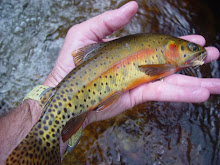Well, after a very long and eventful winter I was finally able to get in some REAL fishing....and it's April!
This event is an annual TU outing for me. Unfortunately it just happened to be the first "real" outing of the year. Fortunately, though, it coincided with my son's spring break and our annual trip to the Smokies - so this would be my son's first Elkhorn Clean-up.
As with many spring outings you must dodge rain and high water, and I've only attended one (of five) Elkhorn clean-ups where high/fast water was not a factor - an this year was not one of them.
We arrived on Friday for the Saturday clean-up, which gave us a full day to fish THE best wild trout stream in the state. In the last 4-5 years, this is the only time of the year where I fish a West Virginia stream that is not a "native" stream.
The flow and the levels were up in the main stream, so it was tough fishing for my son and I. We made the decision to move up one of the tribs...and it was fish on! I caught three of these guys in about five minutes.
I picked up a few more little guys before we made it back to the campground for the annual Friday night dinner and festivities.
We almost made it through dinner before the rain started and we also got a campfire started before the real storms hit! My son and I piled in the camper when the massive storms hit: thunder, lightning, and hail! Our host said that those were some of the worst storms he has ever encountered in a camper.
The next day was the actual clean-up and the numbers were down again this year. We had ~100 volunteers in 2009, ~80 in 2010, and just over 60 this year.
The numbers were down, but it also appeared the trash was too. It may have had something to do with the high flows and storms - most likely it was swept it on downstream.
Before:
During (with my son right in the middle of it):
After:
Following lunch it is usually back to the stream but this year was different; we had high water, forecast for more storms, and plans to head to the Smokies. So, with all of that we packed up and headed south a day earlier than planned.
Next entries will be from our annual father/son trip to the Smokies but first I wanted to post some photos my son took. He likes to carry a camera too. He has already "dunked" one camera so I let him carry my waterproof and he doesn't do too bad. All of these photos were taken by a handheld, underwater, video camera:
Maybe it's just because he's my son, but I think (for a 10-year-old) he does pretty good with a camera.
Chris
This event is an annual TU outing for me. Unfortunately it just happened to be the first "real" outing of the year. Fortunately, though, it coincided with my son's spring break and our annual trip to the Smokies - so this would be my son's first Elkhorn Clean-up.
As with many spring outings you must dodge rain and high water, and I've only attended one (of five) Elkhorn clean-ups where high/fast water was not a factor - an this year was not one of them.
We arrived on Friday for the Saturday clean-up, which gave us a full day to fish THE best wild trout stream in the state. In the last 4-5 years, this is the only time of the year where I fish a West Virginia stream that is not a "native" stream.
The flow and the levels were up in the main stream, so it was tough fishing for my son and I. We made the decision to move up one of the tribs...and it was fish on! I caught three of these guys in about five minutes.
I picked up a few more little guys before we made it back to the campground for the annual Friday night dinner and festivities.
We almost made it through dinner before the rain started and we also got a campfire started before the real storms hit! My son and I piled in the camper when the massive storms hit: thunder, lightning, and hail! Our host said that those were some of the worst storms he has ever encountered in a camper.
The next day was the actual clean-up and the numbers were down again this year. We had ~100 volunteers in 2009, ~80 in 2010, and just over 60 this year.
The numbers were down, but it also appeared the trash was too. It may have had something to do with the high flows and storms - most likely it was swept it on downstream.
Before:
During (with my son right in the middle of it):
After:
Following lunch it is usually back to the stream but this year was different; we had high water, forecast for more storms, and plans to head to the Smokies. So, with all of that we packed up and headed south a day earlier than planned.
Next entries will be from our annual father/son trip to the Smokies but first I wanted to post some photos my son took. He likes to carry a camera too. He has already "dunked" one camera so I let him carry my waterproof and he doesn't do too bad. All of these photos were taken by a handheld, underwater, video camera:
Maybe it's just because he's my son, but I think (for a 10-year-old) he does pretty good with a camera.
Chris
































































